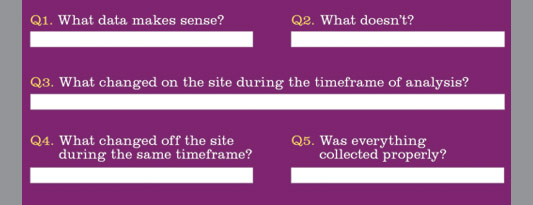Getting the most from Web analytics.
So what? That’s exactly what to ask when you’re presented with a mountain of seemingly relevant and interesting data about your website. The next question should be:
Why? If you’re not asking those questions, it’s possible that you are stuck in information overload. It’s so easy to get a never-ending stream of information for the who, what and when about your site that many site owners never know what to do with it. That’s the goal of web analytics – gathering information in order to understand it and then take action.
The Web Analytics Association defines Web Analytics as:
- “ The measurement, collection, analysis and reporting of Internet data for the purposes of understanding and optimizing Web usage.”
Looking closer at each part of the definition makes it easier to understand. First there’s measurement and collection, then analysis and finally doing something with what we’ve learned.
Modern Web servers and free online tools make collecting and measuring data very easy. Virtually every Web hosting account will provide reports generated by the server about the most popular pages on your website, visiting search engines and a lot more. Tools like Google Analytics provide a similar set of data, but they do it by “watching” what pages get visited on your website after you install a special set of code that allows them to do so. Both methods provide a large amount of interesting information. But they both have certain drawbacks to be aware of. Most Web analysts pay attention to both in order to get the most comprehensive view of what’s happening on a site.
 Since websites are live at all times, the data keeps coming in continuously. Reporting and interpretation of the information is typically broken down into meaningful segments for analysis purposes. Weeks, months, quarters, seasons, promotional periods, days, nights and virtually any other meaningful segmentation you can think of are valid options for analysis. The key factor is to understand what your business goal is when looking at the information.
Since websites are live at all times, the data keeps coming in continuously. Reporting and interpretation of the information is typically broken down into meaningful segments for analysis purposes. Weeks, months, quarters, seasons, promotional periods, days, nights and virtually any other meaningful segmentation you can think of are valid options for analysis. The key factor is to understand what your business goal is when looking at the information.
If you are interested in the activities of foreign visitors, then looking at domestic traffic becomes irrelevant. Visitors who purchased can be reviewed differently than those who didn’t. Analyzing the right data for the right question is essential. To gain the right insights, you have to combine the right pieces of information.
Once you have the reports and related information, the true process of analysis begins.

There are countless factors to consider. Experience in understanding what to look at is where the value of a Web analyst makes a difference.
The next step is to determine what can be done to optimize the site or visitor experience in order to meet your business goal. Perhaps you want people to sign up for your email newsletter. There are typically many things that can be done that will have an impact on user behavior. Web analytics teaches us to take what we know and test what we think is a good course of action.
- Will a larger button make more people click?
- Should the form say, “Free email newsletter?”
- Are you requiring too much information from the subscriber?
By setting up tests, it’s possible to find out exactly what makes an impact. You’re then able to collect data on what happens after you make changes, analyze it and make further decisions based on the new information.
That’s what Web analytics comes down to – a methodology for transforming observation and data into action. It’s a relatively young discipline and maturing every day. Knowing the difference between reporting, analysis and how to take action is the most important part of the equation. Without doing something with the data collected, it’s just a bunch of numbers that look pretty, but are worthless to your bottom line.


